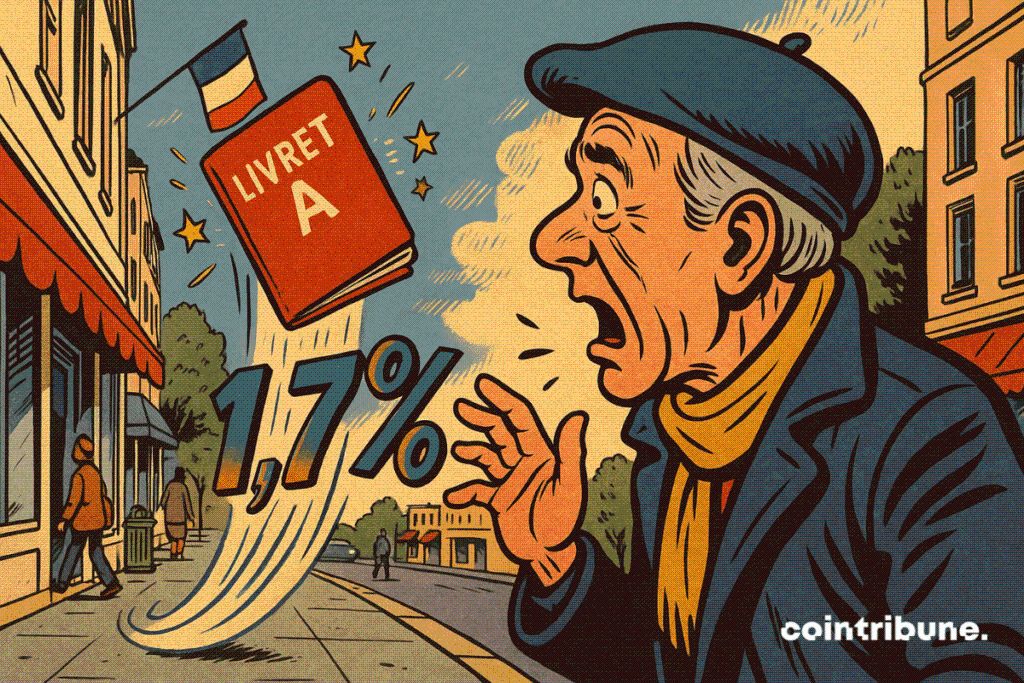Livret A Hits 1.7 % : What's Behind The Government's Move
The preferred savings of the French are about to face a serious setback. The Livret A rate, held by more than 55 million people, will drop to 1.7 % on August 1st, 2025, compared to 2.4 % today. A significant decrease, the largest since 2009, validated by the Banque de France and in accordance with the regulatory formula. In an still fragile economic climate, this decision reignites the debate on the profitability of regulated savings and raises questions about the future choices of savers seeking alternative solutions.

In Brief
- The Livret A rate will drop from 2.4 % to 1.7 % on August 1, 2025, marking its largest drop since 2009.
- This decrease complies with the regulatory formula, based on inflation (0.88% in the first half) and interbank rates.
- The Livret A remains the favorite investment of the French with over 444 billion euros deposited in May 2025.
- The measure aims to reduce the debt burden of HLM organizations, restoring nearly one billion euros of investment over two years.
The Regulatory Turn : a drop guided by the official formula
The Ministry of the Economy officially announced on July 16 a decision that will impact millions of French citizens. The Livret A rate will be reduced to 1.7 % from August 1st, 2025, down from 2.4 % since February .
This represents the largest drop since 2009, applied in accordance with the regulatory formula. This formula is based on two main parameters : the half-year average inflation excluding tobacco and the interbank interest rate in the Eurozone.
The government explains that “the inflation level fell to 0.88 % in the first semester”, making this revision compliant with the rules. The Banque de France, responsible for the technical recommendation, approved the new rate, and Bercy followed without any discretionary adjustment.
Several factual elements help measure the scope of this decision :
- This is the second decrease in 2025 : the rate was still 3 % in January ;
- The Livret A remains the most used savings product in France, with over 444 billion euros deposited in May ;
- The last drop of such magnitude dates back to 2009, in the midst of the financial crisis, when the rate fell to 1.25 % ;
- The 1.7 % rate remains above current inflation, but its rapid fall can weaken savers’ confidence ;
- The calculation formula has not been bypassed: unlike the Popular Savings Booklet, the government did not apply any derogation to limit the decrease.
Far from trivial, this announcement illustrates the fragility of regulated savings’ remuneration against macroeconomic changes. It also highlights the State’s desire to maintain the transparency of the system, despite potentially negative effects on savers’ purchasing power.
The Livret A as a political and financial lever : who benefits from the decrease ?
Beyond its strictly regulatory dimension, this reduction of the Livret A rate also responds to broader economic challenges, particularly in the financing of social housing. Indeed, the government specifies that this decrease will help reduce the debt burden of HLM organizations, a large part of which is indexed to the Livret A rate.
“The drop in the Livret A rate will return nearly one billion euros of investment capacity over two years to social housing actors”, specifies the official Ministry of Economy website. By lowering this financing cost, the state therefore aims to stimulate investments in a strained sector, while avoiding to increase its own public debt.
This budgetary lever fits into a broader economic recovery strategy through supply, aiming to ease credit constraints for social landlords and indirectly reduce costs for SMEs.
Conversely, from the household side, the prospect of a net return below forthcoming real inflation could encourage a gradual disinterest in this type of regulated savings, in favor of more dynamic or alternative products. The Banque de France maintains, however, that the 1.7 % rate remains “net of taxation and above current inflation”, which still makes it a secure option.
In this context of decreasing returns, attention is increasingly turning to alternatives seen as more dynamic. Among them, bitcoin and cryptocurrencies are gaining visibility among savers looking for yield. Though their volatility remains high, their adoption is growing, especially among young professionals. This refocusing of savings strategies could help reshape the French financial landscape, where traditional products struggle to compete with digitally evolving assets driven by scarcity and monetary innovation logic.
In the medium term, if inflation rises again or if savings returns remain persistently below market standards, savings flows could shift to other vehicles, such as life insurance, real estate investment trusts (SCPI), or even cryptocurrencies for more experienced profiles, which could further increase French savings .
Disclaimer: The content of this article solely reflects the author's opinion and does not represent the platform in any capacity. This article is not intended to serve as a reference for making investment decisions.
You may also like
Bitcoin (BTC/USD) Price Alert: Bitcoin Breaks Major Resistance - Next Stop $100,000?

Ethereum treasury demand collapses: Will it delay ETH’s recovery to $4K?

Can BNB price retake $1K in December?

Trending news
More[Bitpush Daily News Selection] Trump actively hints at Hassett as the next Federal Reserve Chairman; Bloomberg: Strategy may consider offering bitcoin lending services in the future; Strategy CEO: Strategy sets $1.4 billion reserve through stock sale to ease bitcoin selling pressure; Sony may launch a US dollar stablecoin for payments in gaming, anime, and other ecosystems
Bitcoin (BTC/USD) Price Alert: Bitcoin Breaks Major Resistance - Next Stop $100,000?

![[Bitpush Daily News Selection] Trump actively hints at Hassett as the next Federal Reserve Chairman; Bloomberg: Strategy may consider offering bitcoin lending services in the future; Strategy CEO: Strategy sets $1.4 billion reserve through stock sale to ease bitcoin selling pressure; Sony may launch a US dollar stablecoin for payments in gaming, anime, and other ecosystems](https://img.bgstatic.com/multiLang/image/social/44682a8c7537c9a9b467e17ed74a704d1764777241317.jpg)